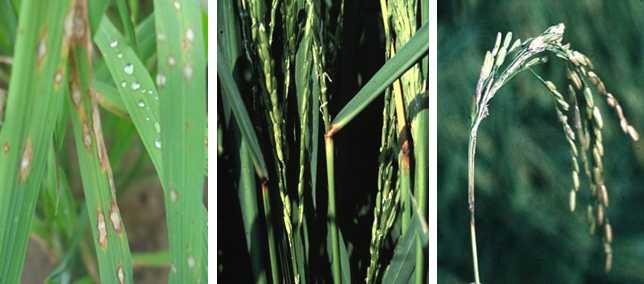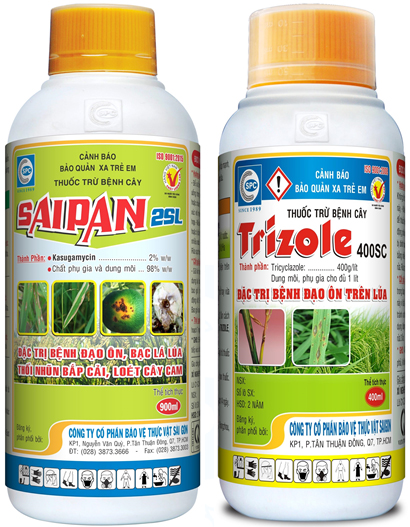|
Blast disease damaging on rice
08/12/2021
Ph.D. Nguyen Minh Tuyen Rice is the main and important crop in our country is agricultural production. However, when rice is intensively cultivated to increase yield and quality, many pests appear. Rice blast is one of the dangerous pests that greatly affects the yield and quality of rice. Previously, blast disease only appeared in the Winter-Spring rice crop. However, in recent years, rice blast has damaged most of the rice crops of the year in the southern provinces. Rice blast disease has increased production costs and made rice farming difficult in Vietnam. * Symptoms and harmful agents: Fungal disease with scientific name: Pyricularia oryzae. The causal fungus can attack on leaves, stalks, panicle, spike necks, rice grains. On the leaves, the lesions were very small at first, but in the middle of the lesions, the leaf cells were necrotic and dry gray, then the lesions grew larger and had a diamond shape, this is a typical disease of rice blast. When the disease is severe, many lesions link together causing the whole leaf to "burn". The most dangerous is when the fungus attacks on the panicle and spike necks, making the whole pannicle and spike dry and broken droopingly...
* Conditions of development: In production conditions in Vietnam, the source of the disease is always available in the field, if it is cloudy, less sunny, cool weather, high humidity, combined with a lot of fog at night, the disease will thrive. The disease also often causes severe damage in fields using infected rice varieties, sowing thickly, applying excess nitrogen fertilizers... * A number of measures to manage blast disease have been effectively applied by farmers: - Before planting, clean the field, clean up the remnants of the previous crop (well level and thoroughly bury stubble, straw) clean the weeds around the borders and irrigation ditches... - Use disease resistant or less susceptible varieties for planting. - Seed treatment before sowing. - Do not sow too thickly so that the rice plants are healthy and resistant to diseases (apply according to the amount of seed recommended by the IPM program, about 120 kg/ha, if sowing in rows the seed quantity is even less). - Fertilize in a reasonable balance, do not apply excess nitrogen, should use fertilizer according to the table of rice leaf color. (When the rice is over-fertilized with nitrogen, the leaves are dark green and the leaf blade will not be upright but horizontal). - Proactively prevent disease when the weather conditions are suitable for the disease to arise and develop (as mentioned above), such as limiting nitrogen fertilizers, increasing potassium fertilizers. Pre-preventive spray can be applied if the field is sown heavily with infected seed and was in excess of nitrogen. - Regular monitoring of the field, especially the stages of rice plants are susceptible to disease (from the rice in flourishing to booting stages). When early disease appears in the field at all stages of rice, stop using nitrogen fertilizer and need to spray or spread one of the following products: + Spray Trizole 400SC/75WP/WDG, or Saipan 2SL. In particular, Trizole 400SC is a new water-based product, very easy to use, with a dosage of 0.5-0.6 liters/ha for very high disease control. Saipan 2SL has just prevented blast and leaf blight disease caused by bacteria. + Additionally broadcast 10GR Kisaigon granular popduct when the rice has root rot. + If the disease develops strongly, it can be sprayed again after 5-7 days. Combine broadcasting granular product. * Attention when spraying: Spray enough water with a finely-sprayed nozzle, spray when the field got dew dried or water dried after rain. Can be sprayed before the rice blooms or after the rice has bloomed evenly. |
To prevent, in addition to plowing and burying weed seeds, collecting weed stalks and stumps left after tilling the land to burn, not letting weeds produce seeds in production fields, etc., the use of chemical products is still a measure. optimal because of its ability to thoroughly kill weeds, reduce labor and take advantage of more time than manual weeding.
Miner has the scientific name Phyllocnistis citrella Staint., family Phyllocnistidae, order Lepidoptera. The miner occurs in many countries in the tropics and subtropics. The main host of the miner is the citrus family - Rutaceae. In addition, the miner also attacks mangosteen and some other plants.
Adult is a small planthopper, with a body 2-3 mm long, the whole body is ash gray, slightly greenish, the wings are opaque with many small brown spots.Eggs are oval, 0.3 mm long, have a pointed end and are attached directly to the leaf surface, leaf axils.
Green bugs specialize in the fruit of citrus groups (oranges, tangerines, lemons, grapefruits, kumquats...), some people call them orange bugs, or orange suckers. Their scientific name is Rhynchocoris poseidon or Rhynchocoris humeralis.
In Vietnam, yellow leaf curl disease is very common on papaya trees, especially the disease is often severe in areas of high and continuous planting, areas with hot and arid climates. The disease has significantly reduced the yield and quality of papaya. Gardens that are infected early when the plants are young may not yield. However, up to now, many gardeners still do not know the cause and how to fix it.
Spider mites are common pests on citrus trees, especially in hot and dry climates that are suitable for spiders to grow and cause severe damage.The group of harmful spiders is usually very small in size, unlike the natural enemy spiders.
This group includes species that are generally very small in size, causing damage by sucking plant sap (on leaves, fruits, branches, stems).
There are many species of mealybugs present on the group of Oranges,Tangerines,Grapefruits and Lemons (Citrus), which can be divided into 2 groups:
+ Group of sticky mealybugs with common varieties such as Lepidosaphes, Aonidiella, Coccus and Saissetia.
+ Group of flower mealybugs with common genera and species such as Pseudococcus, Planococcus and Icerya purchasi.
Dry branches and berries disease often appear to be common damage on coffee gardens during the rainy season. The disease causes death of branchs, dry fruit, severely affects the canopy structure and coffee yield if not paid attention to prevention.
Pink disease commonly causes diseases on rubber plantations in the rainy season, especially on garden from 4-8 years old. This year, rubber has to go through a period of severe drought, weakening the tree, so now in tnshe rainy season it is easy to get infected. Therefore, it is necessary to pay attention to good management to avoid affecting the garden.
In recent years, the area of citrus has been expanded because it is a fruit tree with high economic efficiency. However, in order to sell at a high price, not only in quality but consumers also require the external beauty of the fruit, so pest management on citrus is a matter of great concern to farmers. The hot season is a favorable condition for thrips to develop and cause damage, affecting the commercial value of fruit.
- Headquarters
- SAIGON PLANT PROTECTION JOINT STOCK COMPANY
- RQ 1, Nguyen Van Quy St., Tan Thuan Ward, HCM City
- Tax code: 0300632232
- Tel: (028) 38 733 295 - 38 732 077
- Fax: (028) 38 733 003 - 38 733 391
- Website: www.spchcmc.vn - Email: info@spchcmc.vn
- SAIGON PLANT PROTECTION COMPANY
- SAIGON PLANT PROTECTION JOINT STOCK ENTERPRISE
- Lot C1-C3 Hiep Phuoc Industrial Park, Hiep Phuoc Commune, HCM City
- Tel: (028) 3873 4089 - Fax: (028) 3873 4086
- Affiliated Unit
-
- Quick Links
- Home
- About us
- Career Opportunities













